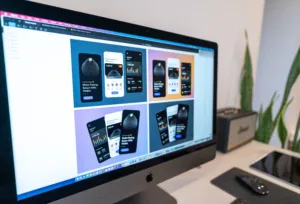Hook:
In the fast-paced symphony of technological evolution, the canvas of modern web design continuously transforms, adapting to the demands of a dynamic digital landscape. What was once a static panorama has now become a fluid, responsive medium, constantly reshaping itself to accommodate the diverse ways users interact with the online realm.
Introduction to the Title:
Embark with us on a captivating exploration into the heart of the digital revolution — a narrative that unfolds under the banner of “Responsive Brilliance.” This is more than just a discussion on modern web design; it’s an odyssey through the fusion of artistic ingenuity and scientific precision that defines the aesthetics and functionality of modern web design.
Brief Overview:
In the intricate tapestry of the contemporary digital landscape, the significance of ‘Responsive Design’ cannot be overstated. As users seamlessly transition between devices of varying shapes and sizes, the modern web designer faces the challenge of crafting not just a visually appealing interface, but an adaptive, user-centric experience. Join us on this journey as we unravel the layers of complexity inherent in the art and science of revolutionizing modern web design.
The Imperative of Responsive Design

Definition and Significance:
At the core of the digital revolution lies the concept of responsive design, a paradigm that transcends the static boundaries of traditional web layouts. Responsive design is more than a set of techniques; it’s a philosophy that dictates a website’s ability to adapt seamlessly to a multitude of devices, from the expansive screens of desktops to the compact displays of smartphones and tablets. In essence, it’s the art of crafting a digital experience that remains consistently compelling, regardless of the device at hand.
Mobile Dominance:
In an era where mobile devices reign supreme, the importance of a responsive approach becomes glaringly evident. The ubiquity of smartphones and tablets has fundamentally altered the way users access and consume digital content. From online shopping to content consumption, mobile devices have become the gateway to the digital realm. Acknowledging this mobile dominance is not just a strategic choice; it’s a necessity. A responsive approach ensures that your digital presence is not only visually appealing on the larger screens but equally captivating and functional on the smaller, handheld ones. It’s a shift in perspective that aligns your design ethos with the behavioral patterns of a generation that constantly seeks information, entertainment, and services on the go.
Power of Visual Appeal
Creative Typography:
In the realm of modern web design, typography emerges as a potent artistic tool, transcending its functional origins. Creative typography goes beyond mere text; it becomes a visual element that communicates brand personality and enhances the overall aesthetic. The choice of fonts, their sizes, and the spacing between letters all contribute to the visual appeal of a website. Typography isn’t just about words; it’s about crafting a visual language that resonates with the audience, setting the tone for the entire user experience.
Color Psychology:
Enter the vibrant world of color, where hues and shades are not just visual elements but powerful communicators of emotion and meaning. Color schemes in web design are more than just aesthetic choices; they wield a psychological influence on user perception and behavior. Whether it’s the calming effect of blues, the vibrancy of reds, or the trustworthiness associated with greens, each color has a story to tell. Understanding color psychology allows designers to evoke specific emotions, create memorable brand experiences, and guide users through a visually cohesive journey.
High-Quality Imagery:
In the age of digital storytelling, high-quality imagery stands as a cornerstone of engaging user experiences. Compelling visuals not only capture attention but also convey a brand’s narrative. From stunning product photographs to impactful hero images, the visual elements of a website play a pivotal role in shaping user impressions. High-quality imagery goes beyond aesthetics; it establishes a visual identity that users can connect with, fostering brand loyalty and leaving a lasting impact.
Strategies for Modern Layouts
CSS Grid and Flexbox:
At the forefront of modern web design, the dynamic duo of CSS Grid and Flexbox redefine the landscape of layout possibilities. These technologies transcend traditional constraints, empowering designers to create responsive and flexible layouts with unparalleled ease. CSS Grid provides a two-dimensional grid system, enabling precise control over both rows and columns, while Flexbox allows for fluid arrangements of elements within a single dimension. Together, they form the backbone of contemporary layouts, offering a level of design freedom that adapts seamlessly to the diversity of devices and screen sizes.
Innovative Navigation:
Navigating the digital expanse has evolved beyond traditional menu bars and linear pathways. Modern web design embraces innovative navigation approaches that prioritize user experience. From sticky menus that follow users as they scroll to hidden navigation panels that reveal themselves at the touch of a button, the goal is to provide intuitive and engaging pathways through the digital space. By adopting creative and user-centric navigation strategies, websites can enhance accessibility, encourage exploration, and elevate the overall satisfaction of the online journey.
Dynamic Content Loading:
In a world where attention spans are fleeting, the optimization of content loading takes center stage. Dynamic content loading techniques revolutionize the user experience by prioritizing what users see based on their interactions. From lazy loading images to asynchronous loading of additional content, these techniques ensure that users are presented with relevant information promptly, creating a seamless and engaging browsing experience. By strategically managing the loading of content, websites can strike a balance between visual appeal and optimal performance.
Interactivity and User Engagement

Microinteractions:
In the intricate dance between user and interface, micro-interactions take center stage, transforming the ordinary into moments of delight. These subtle, often overlooked details play a significant role in enhancing user experience and engagement. From the satisfying click of a button to the gentle notification sound, micro-interactions provide feedback, convey information, and inject personality into the user journey. By meticulously crafting these micro-moments, designers can create a user experience that feels responsive, intuitive, and inherently satisfying.
Web Animation Techniques:
The canvas of modern web design comes alive with the strategic incorporation of animations. Beyond mere visual flair, animations serve a dual purpose — improving interactivity and elevating visual appeal. Whether it’s a smooth transition between sections, a playful hover effect, or a narratively driven scrolling animation, each motion is a deliberate choice to captivate the audience. Web animation techniques, when wielded with purpose, create a dynamic and immersive user experience, fostering engagement and leaving a lasting impression.
User-Centric Approach:
At the core of successful modern web design lies a commitment to the user-centric approach. Designing with the user in mind means more than just creating aesthetically pleasing visuals; it involves understanding the needs, preferences, and behaviors of the target audience. By empathetically considering the user’s journey, designers can craft interfaces that prioritize clarity, ease of navigation, and overall satisfaction. The user-centric approach is a guiding principle that ensures every design decision contributes to a seamless and enjoyable online experience.
The Role of Technology

JavaScript Frameworks:
In the ever-evolving landscape of web design, JavaScript frameworks stand as pillars of innovation, shaping the digital experiences we encounter daily. An analysis of popular frameworks such as React, Angular, or Vue.js reveals the transformative impact they bring to the table. These frameworks empower developers to build dynamic, responsive, and interactive user interfaces, setting the foundation for modern web design practices. The judicious use of JavaScript frameworks is not merely a technical choice but a strategic decision to enhance the overall user experience.
Progressive Web Apps (PWAs):
The dawn of Progressive Web Apps (PWAs) marks a paradigm shift in how users interact with online content. Exploring the concept of PWAs unveils a hybrid approach that seamlessly merges the best of both web and native applications. With benefits ranging from offline functionality to fast loading speeds, PWAs offer users a smooth, app-like experience directly through their web browsers. As we dissect the anatomy of PWAs, it becomes evident that embracing this technology is a gateway to providing a truly seamless and accessible user experience.
Scalable Vector Graphics (SVG):
In the quest for responsive and high-quality graphics, Scalable Vector Graphics (SVG) emerge as the unsung heroes of modern web design. Unpacking the utilization of SVG reveals a versatile format that adapts effortlessly to various screen sizes without compromising quality. Whether it’s logos, icons, or intricate illustrations, SVG ensures that graphics remain sharp and clear across a diverse array of devices. Understanding the role of SVG in web design is not just a technical consideration but a strategic move toward creating visually stunning and universally accessible digital content.
Orchestrating User Engagement
Microinteractions: Symphony of Subtle Engagements
In the grand symphony of user experiences, micro-interactions emerge as the delicate notes that elevate digital interactions from functional to delightful. Let’s delve into the subtle ballet of user interactions, where every click, hover, and scroll is a carefully choreographed movement, adding depth and nuance to the overall user journey.
The Subtle Ballet of User Interactions:
In the realm of micro-interactions, simplicity meets significance. These are the nuanced gestures that go beyond mere functionality, creating a dance of digital delight. Whether it’s the satisfying click of a button, a subtle notification sound, or the smooth transition between states, micro-interactions contribute to an intuitive and engaging user experience.
Animating Experiences: Web Animation Techniques
As we explore the realm of user engagement, the canvas comes alive with web animation techniques. Here, we embark on a journey of choreographing user experiences through animation, discovering how dynamic motion can not only capture attention but also elevate the overall visual appeal of a website.
Choreographing User Experiences through Animation:
Web animation is more than a stylistic choice; it’s a strategic tool for guiding users through a seamless and captivating journey. From subtle hover effects that provide feedback to narrative-driven scrolling animations that tell a story, each animation serves a purpose. By choreographing these motions with precision, designers can shape a user experience that feels dynamic, interactive, and inherently engaging.
Elevating Visual Appeal through Dynamic Motion:
The allure of dynamic motion extends beyond mere aesthetics; it captivates and holds the user’s attention. Whether it’s a smooth transition between sections, a playful bounce upon interaction, or a loading animation that transforms waiting into an engaging moment, dynamic motion enhances the visual appeal of a website. Through strategic animation, designers infuse energy and vibrancy into the digital canvas.
User at the Core: Crafting a User-Centric Design
In the symphony of design, the user takes center stage. Crafting a user-centric design involves more than just aesthetics; it requires designing with empathy and adopting holistic approaches that prioritize the user’s needs, preferences, and journey.
Designing with Empathy: User-Centric Philosophies:
Empathy is the cornerstone of user-centric design. It involves putting oneself in the user’s shoes, understanding their challenges, and anticipating their expectations. Designing with empathy means creating interfaces that are not just visually pleasing but also intuitive and user-friendly.
Holistic User-Centric Approaches for Seamless Experiences:
A user-centric approach extends beyond individual interactions; it encompasses the entire user journey. From the first visit to ongoing engagement, designers adopting holistic user-centric approaches ensure that every touchpoint is crafted with the user’s satisfaction in mind. This approach leads to seamless experiences, where each element aligns cohesively to create a journey that feels natural and enjoyable.
Strategies for SEO-Friendly Design
SEO-Friendly Web Design:
In the intricate dance of digital visibility, the choreography of SEO-friendly web design takes center stage. Detailing the best practices for optimizing web design for search engines is not just a technical necessity but a strategic choice to ensure your digital footprint resonates with algorithms and users alike. From crafting clean and crawlable code to prioritizing mobile responsiveness, every design decision becomes a brushstroke in the canvas of discoverability. By aligning visual aesthetics with SEO imperatives, web designers pave the way for websites to ascend the ranks of search engine results, ensuring they’re not just beautiful but also easily found.
A/B Testing in Modern Web Design:
The journey towards a refined and user-centric design is paved with insights derived from A/B testing. Discussing the use of A/B testing in modern web design unveils a methodical approach to refining design choices based on real-time user interactions. By presenting variations of a design element to different user segments and analyzing their responses, designers gain invaluable data that guides decision-making. A/B testing isn’t merely about tweaking colors or layouts; it’s a dynamic tool that enhances user engagement, reduces bounce rates, and ultimately contributes to the evolution of a website that truly resonates with its audience.
Case Studies in Modern Web Design:
Embarking on a journey through the digital landscape, we turn our gaze toward exemplary websites that stand as living testaments to the principles of modern web design. These digital marvels not only showcase but embody the strategies we’ve explored. By dissecting and showcasing successful websites, we illuminate the practical application of the discussed strategies. These exemplars serve as beacons, guiding the way for designers seeking inspiration and insight into the realm of responsive brilliance.
Analysis of Modern Web Design:
The true essence of understanding modern web design lies not just in theory but in the practical impact it has on user experiences. In this section, we delve into a meticulous analysis, providing a comprehensive breakdown of the standout features that make these websites exceptional. From innovative navigation to seamless interactivity, each element is dissected to reveal its role in enhancing the overall user experience. This analytical journey is not merely a deconstruction; it’s a gateway to gleaning insights that can be applied to future design endeavors. By understanding the impact of these features, designers can elevate their craft and contribute to the ever-evolving landscape of modern web design.
Culmination and Future Gazing – Responsive Brilliance in Modern Web Design:
As we stand at the nexus of our exploration into modern web design, it’s imperative to cast our eyes backward and encapsulate the essence of responsive brilliance. In recapping the seven pillars that underscore this transformative journey, we unveil a holistic understanding of what it takes to craft digital experiences that resonate with both artistry and precision.
Future Gazing in Modern Web Design:
In concluding this odyssey, we turn our gaze toward the future of modern web design. The canvas is expansive, and the brush strokes of innovation await daring hands. As technologies evolve and user expectations soar, the future beckons designers to be pioneers in uncharted realms. It’s not merely about adapting to change but becoming architects of the change itself.
Conclusion – Crafting the Future of Modern Web Design:
As we draw the curtain on our exploration of modern web design, let’s take a moment to recap the seven strategies that form the backbone of responsive brilliance. From the foundational principles of responsive design to the intricate details of typography and color psychology, each strategy contributes to the holistic tapestry of a digital experience that not only captivates but adapts seamlessly to the diverse needs of users.
Armed with this arsenal of strategies, we extend fervent encouragement to our readers. The world of web design is a dynamic canvas, and your role as a designer is pivotal. Apply these strategies in your web design projects, experiment, and innovate. Let each line of code and each design choice echo the principles we’ve explored, creating digital landscapes that resonate with users and stand the test of technological evolution.
In the ever-evolving panorama of technology and design, the future of modern web design is a canvas waiting to be painted. It’s a future where aesthetics and functionality intertwine, where user experiences are not just seamless but awe-inspiring. As we navigate this future, remember that the strategies we’ve uncovered are not just tools; they are beacons guiding us toward a digital realm where every interaction is an exquisite dance of art and science. The future of modern web design beckons, inviting designers to be the architects of digital experiences that transcend the ordinary and embrace the extraordinary.



